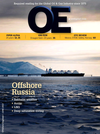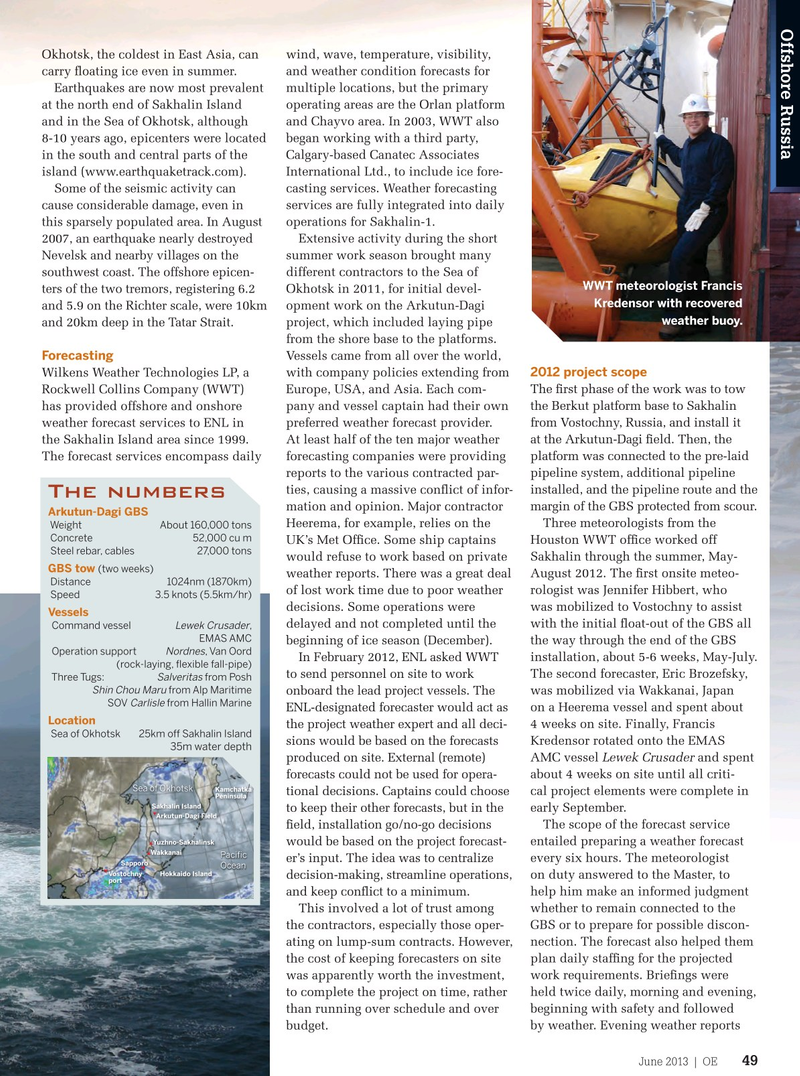
Page 47: of Offshore Engineer Magazine (Jun/Jul 2013)
Read this page in Pdf, Flash or Html5 edition of Jun/Jul 2013 Offshore Engineer Magazine
Offshore Russia
Okhotsk, the coldest in East Asia, can wind, wave, temperature, visibility, carry foating ice even in summer. and weather condition forecasts for
Earthquakes are now most prevalent multiple locations, but the primary at the north end of Sakhalin Island operating areas are the Orlan platform and in the Sea of Okhotsk, although and Chayvo area. In 2003, WWT also 8-10 years ago, epicenters were located began working with a third party, in the south and central parts of the Calgary-based Canatec Associates island (www.earthquaketrack.com). International Ltd., to include ice fore-
Some of the seismic activity can casting services. Weather forecasting cause considerable damage, even in services are fully integrated into daily this sparsely populated area. In August operations for Sakhalin-1. 2007, an earthquake nearly destroyed Extensive activity during the short
Nevelsk and nearby villages on the summer work season brought many southwest coast. The offshore epicen- different contractors to the Sea of
WWT meteorologist Francis ters of the two tremors, registering 6.2 Okhotsk in 2011, for initial devel-
Kredensor with recovered and 5.9 on the Richter scale, were 10km opment work on the Arkutun-Dagi weather buoy.
and 20km deep in the Tatar Strait. project, which included laying pipe from the shore base to the platforms.
Forecasting Vessels came from all over the world,
Wilkens Weather Technologies LP, a with company policies extending from 2012 project scope
Rockwell Collins Company (WWT) Europe, USA, and Asia. Each com- The frst phase of the work was to tow has provided offshore and onshore pany and vessel captain had their own the Berkut platform base to Sakhalin weather forecast services to ENL in preferred weather forecast provider. from Vostochny, Russia, and install it the Sakhalin Island area since 1999. At least half of the ten major weather at the Arkutun-Dagi feld. Then, the
The forecast services encompass daily forecasting companies were providing platform was connected to the pre-laid reports to the various contracted par- pipeline system, additional pipeline ties, causing a massive confict of infor- installed, and the pipeline route and the
The numbers mation and opinion. Major contractor margin of the GBS protected from scour.
Arkutun-Dagi GBS
Heerema, for example, relies on the Three meteorologists from the Weight About 160,000 tons Concrete 52,000 cu m
UK’s Met Offce. Some ship captains Houston WWT offce worked off Steel rebar, cables 27,000 tons would refuse to work based on private Sakhalin through the summer, May-
GBS tow (two weeks) weather reports. There was a great deal August 2012. The frst onsite meteo- Distance 1024nm (1870km) of lost work time due to poor weather rologist was Jennifer Hibbert, who Speed 3.5 knots (5.5km/hr) decisions. Some operations were was mobilized to Vostochny to assist
Vessels delayed and not completed until the with the initial foat-out of the GBS all Command vessel ,
Lewek Crusader
EMAS AMC beginning of ice season (December). the way through the end of the GBS
Nordnes Operation support , Van Oord
In February 2012, ENL asked WWT installation, about 5-6 weeks, May-July. (rock-laying, fexible fall-pipe) to send personnel on site to work The second forecaster, Eric Brozefsky,
Salveritas Three Tugs: from Posh
Shin Chou Maru from Alp Maritime onboard the lead project vessels. The was mobilized via Wakkanai, Japan Carlisle SOV from Hallin Marine
ENL-designated forecaster would act as on a Heerema vessel and spent about
Location the project weather expert and all deci- 4 weeks on site. Finally, Francis Sea of Okhotsk 25km off Sakhalin Island sions would be based on the forecasts Kredensor rotated onto the EMAS 35m water depth produced on site. External (remote) AMC vessel Lewek Crusader and spent forecasts could not be used for opera- about 4 weeks on site until all criti-
Sea of Okhotsk
Kamchatka tional decisions. Captains could choose cal project elements were complete in
Peninsula
Sakhalin Island to keep their other forecasts, but in the early September.
Arkutun-Dagi Field feld, installation go/no-go decisions The scope of the forecast service
Yuzhno-Sakhalinsk would be based on the project forecast- entailed preparing a weather forecast
Wakkanai
Pacific er’s input. The idea was to centralize every six hours. The meteorologist
Sapporo
Ocean
Vostochny Hokkaido Island decision-making, streamline operations, on duty answered to the Master, to port and keep confict to a minimum. help him make an informed judgment
This involved a lot of trust among whether to remain connected to the the contractors, especially those oper- GBS or to prepare for possible discon- ating on lump-sum contracts. However, nection. The forecast also helped them the cost of keeping forecasters on site plan daily staffng for the projected was apparently worth the investment, work requirements. Briefngs were to complete the project on time, rather held twice daily, morning and evening, than running over schedule and over beginning with safety and followed budget. by weather. Evening weather reports oedigital.com June 2013 | OE 49
Russia2-Sakhalin.indd 49 5/29/13 4:11 PM

 46
46

 48
48